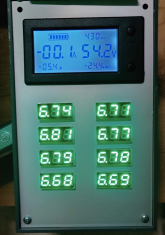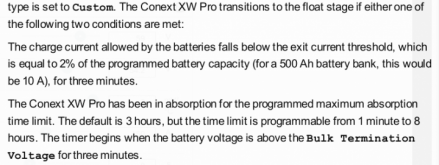Halfwalker
New Member
- Joined
- Feb 1, 2021
- Messages
- 8
Our setup here in CT consists of a Schneider XW Pro inverter, 8x Crown CR-430 batteries for 48V. The XW Pro is a replacement for a pair of ancient Trace SW4024 workhorses that were killed in the hurricane last year. 4x of the batteries are 1 year old, used with the SW4024 setup in 24V. They saw maybe 7 discharge/charge cycles. When we got the XW Pro we got 4x more of the exact same CR-430 battery to make up the 48V bank.
System went live last Nov, and I've done 2 full battery capacity tests, taking it down to 55% SOC and recharging, plus another 2 smaller tests only down to maybe 80% SOC. We get about 8 hours runtime on battery, and it takes the generator about 3 hours to fully recharge from 55%.
I built a small meter to monitor the individual batteries ... The middle 4 voltages are the older batteries. String goes from upper-left negative down, then to lower right and up to upper right positive.

The individual voltages are within 0.02V. I've checked the batteries several times over the weeks with two different multimeters, and they might say one battery is 6.72V when the monitor here says it's 6.74V. So fairly good accuracy. The widest battery-battery difference in this image is 6.68-6.81, or 0.13V +- 0.02V. So the max variation might be 0.17V, but might be as low as 0.09V.
The question is, at what point in that variation should an equalization run be performed ?
System went live last Nov, and I've done 2 full battery capacity tests, taking it down to 55% SOC and recharging, plus another 2 smaller tests only down to maybe 80% SOC. We get about 8 hours runtime on battery, and it takes the generator about 3 hours to fully recharge from 55%.
I built a small meter to monitor the individual batteries ... The middle 4 voltages are the older batteries. String goes from upper-left negative down, then to lower right and up to upper right positive.

The individual voltages are within 0.02V. I've checked the batteries several times over the weeks with two different multimeters, and they might say one battery is 6.72V when the monitor here says it's 6.74V. So fairly good accuracy. The widest battery-battery difference in this image is 6.68-6.81, or 0.13V +- 0.02V. So the max variation might be 0.17V, but might be as low as 0.09V.
The question is, at what point in that variation should an equalization run be performed ?







